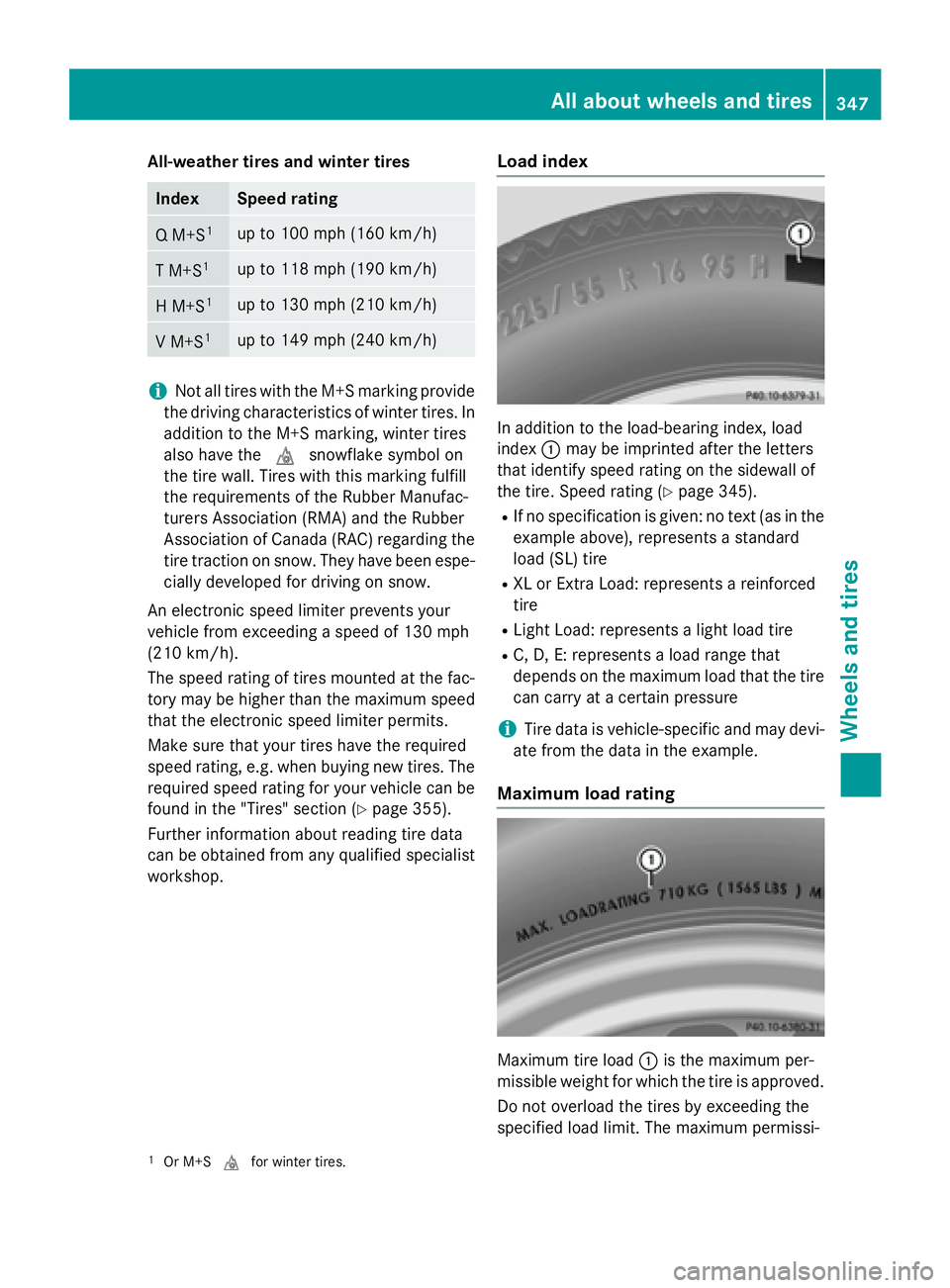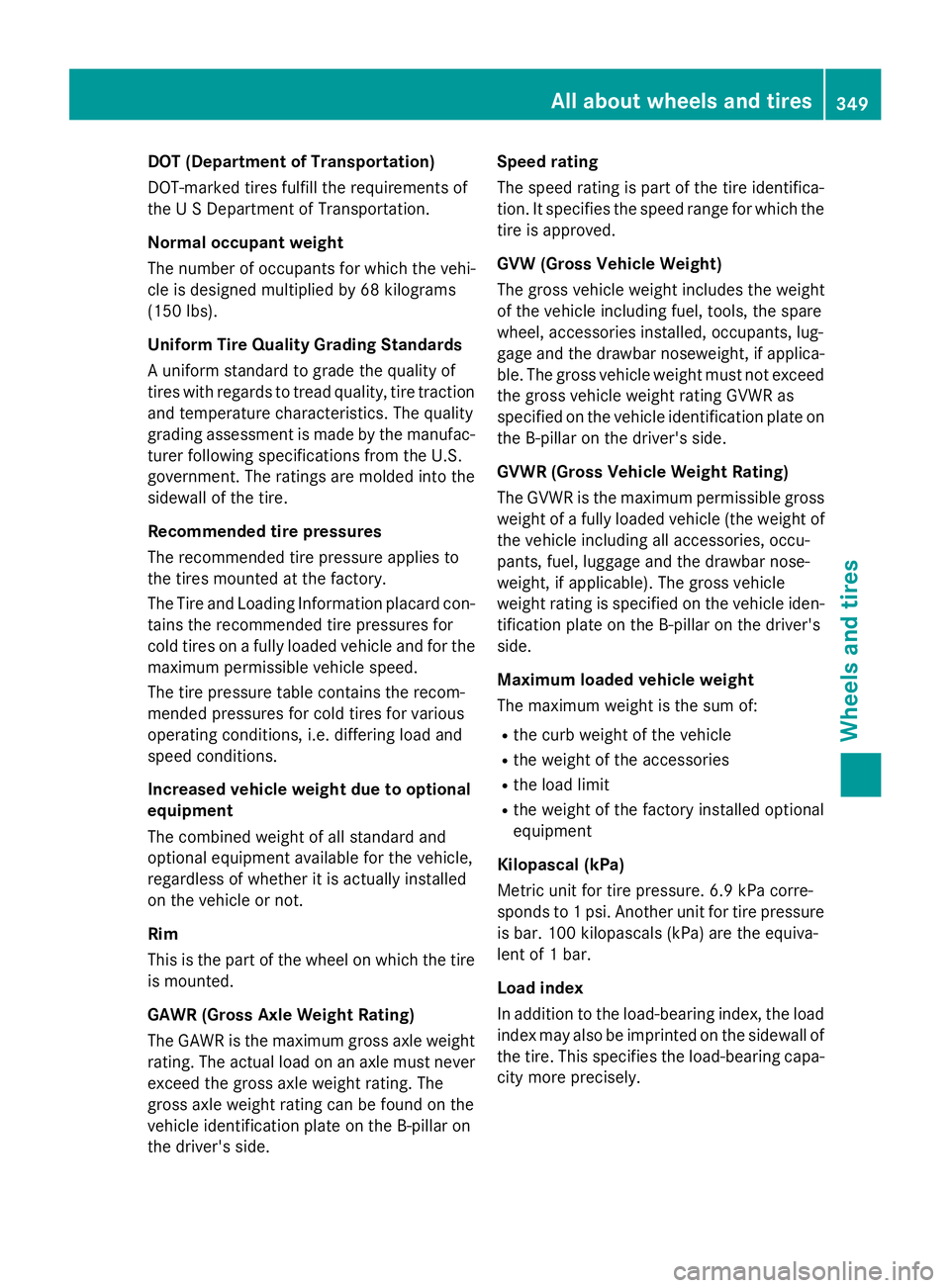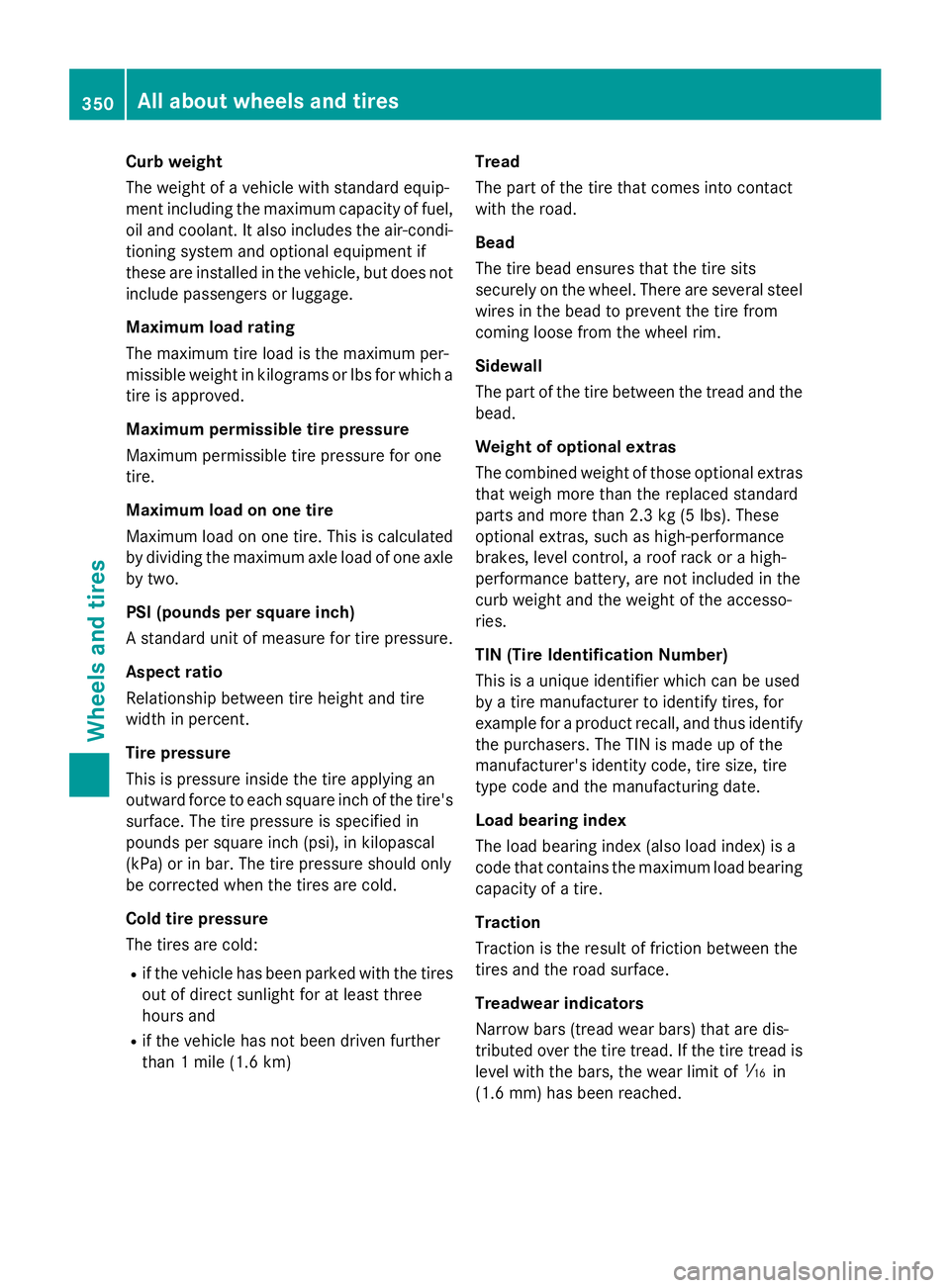Page 345 of 374
Step 3
Example 1 Example 2 Example 3
Permissible load
(maximum gross vehi-
cle weight rating from
the Tire and Loading
Information placard
minus the gross
weight of all occu-
pants) 1500 lbs (680 kg) �
Page 349 of 374

All-weather tires and winter tires
Index Speed ra ting
Q M+S 1
up to 100 mph (160 km/h)
T M+S 1
up to 118 mph (190 km/h)
H M+S 1
up to 130 mph (210 km/h)
V M+S 1
up to 149 mph (240 km/h)
i Not all tires with the M+S marking provide
the driv ing characteristics of winter tires. In
addit ion to the M+S marking, winter tires
also have the �M snowflake symbol on
the tire wall. Tires wit h this marking fulfill
the requirements of the Rubber Manufac-
turers Association (RMA) and the Rubber
Association of Canada (RAC) regarding the
tire traction on snow. They have been espe-
cial ly developed for driving on snow.
An electron ic speed limiter prevents your
veh icle from exceeding a speed of 130 mph
(21 0 km/ h) .
The speed rating of tires mounted at the fac-
tory may be higher than the maximum speed
that the electronic speed limiter permits.
Make sure that your tires have the required
speed rating, e.g. when buying new tires. The
required speed rating for your vehicle can be
found in the "Tires" section ( Y
page 355).
Further information about reading tire data
can be obtained from any qualified specialist
workshop. Load index
In addition to the load-bearing index, load
index �C may be imprinted after the letters
that identify speed rating on the sidewall of
the tire. Speed rating ( Y
page 345).R
If no specification is given: no text (as in the
example above), represents a standard
load (SL) tire R
XL or Extra Load: represents a reinforced
tire R
Light Load: represents a light load tire R
C, D, E: represents a load range that
depends on the maximum load that the tire
can carry at a certain pressure
i Tire data is vehicle-specific and may devi-
ate from the data in the example.
Maximum load rating
Maximum tire load �C is the maximum per-
missible weight for which the tire is approved.
Do not overload the tires by exceeding the
specified load limit. The maximum permissi-1
Or M+S �M for winter tires. All about wheels and tires 347
Wheels and tires Z
Page 351 of 374

DOT (Department of Transportation)
DOT-marke d tires fulfill th e requirements of
th e U S Departmen t of Transportation .
Normal occupant weigh t
The number of occupant s fo r whic h th e vehi-
cle is designed multiplie d by 68 kilograms
(15 0 lbs) .
Unifor m Tire Qualit y Grading Standards
A uniform standard to grade th e qualit y of
tires wit h regards to tread quality, tire traction
and temperature characteristics . The qualit y
gradin g assessmen t is made by th e manufac -
turer following specification s from th e U.S.
government. The ratings are molded into th e
sidewall of th e tire.
Recommended tire pressure s
The recommended tire pressur e applies to
th e tires mounted at th e factory.
The Tir e and Loadin g Information placard con-
tains th e recommended tire pressures fo r
cold tires on a full y loade d vehicl e and fo r th e
maximum permissibl e vehicl e speed.
The tire pressur e table contain s th e recom-
mended pressures fo r cold tires fo r various
operating conditions, i.e. differin g load and
speed conditions.
Increased vehicle weigh t du e to optiona l
equipment
The combine d weight of all standard and
optional equipmen t available fo r th e vehicle,
regardless of whether it is a ctually installed
o n th e vehicl e or not.
Ri m
This is th e part of th e whee l on whic h th e tire
is mounted.
GAW R (Gross Axle Weight Rating)
The GAW R is th e maximum gross axl e weight
rating. The actual load on an axl e mus t never
exceed th e gross axl e weight rating. The
gross axl e weight ratin g can be found on th e
vehicl e identification plat e on th e B-pillar on
th e driver's side . Speed rating
The speed ratin g is part of th e tire identifica-
tion . It specifies th e speed range fo r whic h th e
tire is approved.
GV W (Gross Vehicle Weight )
The gross vehicl e weight includes th e weight
of th e vehicl e includin g fuel , tools , th e spar e
wheel, accessories installed , occupants, lug-
gage and th e drawbar noseweight , if applica-
ble. The gross vehicl e weight mus t no t exceed
th e gross vehicl e weight ratin g GVWR as
specified on th e vehicl e identification plat e on
th e B-pillar on th e driver's side .
GVWR (Gross Vehicle Weight Rating)
The GVWR is th e maximum permissibl e gross
weight of a full y loade d vehicl e (the weight of
th e vehicl e includin g all accessories, occu-
pants , fuel, luggage and th e drawbar nose-
weight , if applicable). The gross vehicl e
weight ratin g is specified on th e ve hicl e i
den -
tification plat e on th e B-pillar on th e driver's
side .
Maximum loaded vehicle weigh t
The maximum weight is th e sum of :R
th e cur b weight of th e vehicl eR
th e weight of th e accessories R
th e load limi t R
th e weight of th e factory installed optional
equipmen t
Kilopascal (kPa)
Metric uni t fo r tire pressure. 6. 9 kP a corre-
spond s to 1 psi . Another uni t fo r tire pressur e
is bar. 10 0 kilopascal s (kPa) are th e equiva-
len t of 1 bar.
Load index
In addition to th e load-bearin g index , th e load
index may also be imprinte d on th e sidewall of
th e tire. This specifies th e load-bearin g capa-
cit y mor e precisely.All about wheels and tires 34 9
Wheels and tires Z
Page 352 of 374

Curb weight
The weight of a vehicle with standard equip-
ment including the maximum capacity of fuel,
oil and coolant. It also includes the air-condi-
tioning system and optional equipment if
these are installed in the vehicle, but does not
include passengers or luggage.
Maximum load rating
The maximum tire load is the maximum per-
missible weight in kilograms or lbs for which a
tire is approved.
Maximum permissible tire pressure
Maximum permissible tire pressure for one
tire.
Maximum load on one tire
Maximum load on one tire. This is calculated
by dividing the maximum axle load of one axle
by two.
PSI (pounds per square inch)
A standard unit of measure for tire pressure.
Aspect ratio
Relationship between tire height and tire
width in percent.
Tire pressure
This is pressure inside the tire applying an
outward force to each square inch of the tire's
surface. The tire pressure is specified in
pounds per square inch (psi), in kilopascal
(kPa) or in bar. The tire pressure should only
be corrected when the tires are cold.
Cold tire pressure
The tires are cold: R
if the vehicle has been parked with the tires
out of direct sunlight for at least three
hours and R
if the vehicle has not been driven further
than 1 mile (1.6 km) Tread
The part of the tire that comes into contact
with the road.
Bead
The tire bead ensures that the tire sits
securely on t h
e wheel. There are several steel
wires in the bead to prevent the tire from
coming loose from the wheel rim.
Sidewall
The part of the tire between the tread and the
bead.
Weight of optional extras
The combined weight of those optional extras
that weigh more than the replaced standard
parts and more than 2.3 kg (5 lbs). These
optional extras, such as high-performance
brakes, level control, a roof rack or a high-
performance battery, are not included in the
curb weight and the weight of the accesso-
ries.
TIN (Tire Identification Number)
This is a unique identifier which can be used
by a tire manufacturer to identify tires, for
example for a product recall, and thus identify
the purchasers. The TIN is made up of the
manufacturer's identity code, tire size, tire
type code and the manufacturing date.
Load bearing index
The load bearing index (also load index) is a
code that contains the maximum load bearing
capacity of a tire.
Traction
Traction is the result of friction between the
tires and the road surface.
Treadwear indicators
Narrow bars (tread wear bars) that are dis-
tributed over the tire tread. If the tire tread is
level with the bars, the wear limit of �
Page 374 of 374
Dimensions an d weights
Model
�C
Openin g
height
Mercedes ‑ AMG vehi-
cles 68.0 in
(1727 mm)
All other model s
68.9 in
(1749 mm)
Model
Vehicle width
including exterior
mirror s 80.0 in (2032 mm)
Wheelbase
106. 3 in (2699 mm )
Turning radiu s
36.1 ft (11.0 m)
Maxi mum trunk
load 220.5 lb (100 kg)
Maximum roof
load 220.5 lb (100 kg)
Model Vehicle length
Mercedes ‑ AMG
vehicles 184.7 in
(4691 mm)
All other models
182.3 in
(4630 mm) Model Vehicle height
Mercedes ‑ AMG
vehicles 55.7 in (1416 mm)
All other models
56.5 in (1436 mm)372
Vehicle data
Technical data
Page:
< prev 1-8 9-16 17-24